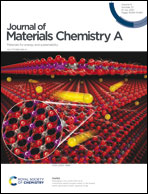Nano beta zeolites catalytic-cracking effect on hydrochlorofluorocarbon molecule for specific detection of Freon†
Abstract
Freon R22 is a typical hydrochlorofluorocarbon (HCFC) that has been widely used as a refrigerant. The leakage of the gas not only increases energy consumption of the refrigeration system but also is harmful to the environment, and thereby needs to be detected. Unfortunately, the highly inert chemical gas molecules at trace concentration levels are difficult to be detected using conventional gas sensing methods. This study conceives to firstly decompose the inert Freon molecule into chemically active substances by catalysis and then realize specific detection with a semiconductor gas sensing material. According to the concept, nano beta zeolite (n-BEA) with an optimized Si/Al atomic ratio is proposed and synthesized as the catalyst to help ZnO nanowires achieve chemical sensing specificity for the naturally inert R22. The n-BEA with Si/Al ratio of 20 (named n-BEA-20) exhibits the strongest catalytic sensitization effect for ZnO-nanowires to detect Freon R22. Catalyzed by the optimal n-BEA-20 sample, the inert Freon R22 molecules are proved to be decomposed and transformed into active radicals that further react with oxygen species (already adsorbed at the surface of the ZnO nanowires) and release electrons to generate a satisfactory sensing signal. The fabricated Freon R22 sensor features a far better limit of detection (LOD) of 100 ppb than the reported Freon sensors, thereby is promising in various Freon detection applications.



 Please wait while we load your content...
Please wait while we load your content...